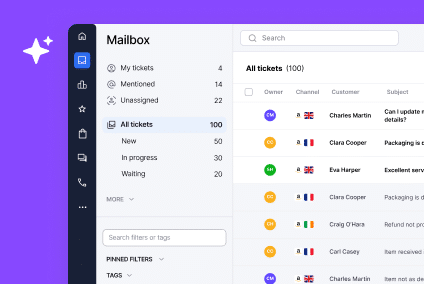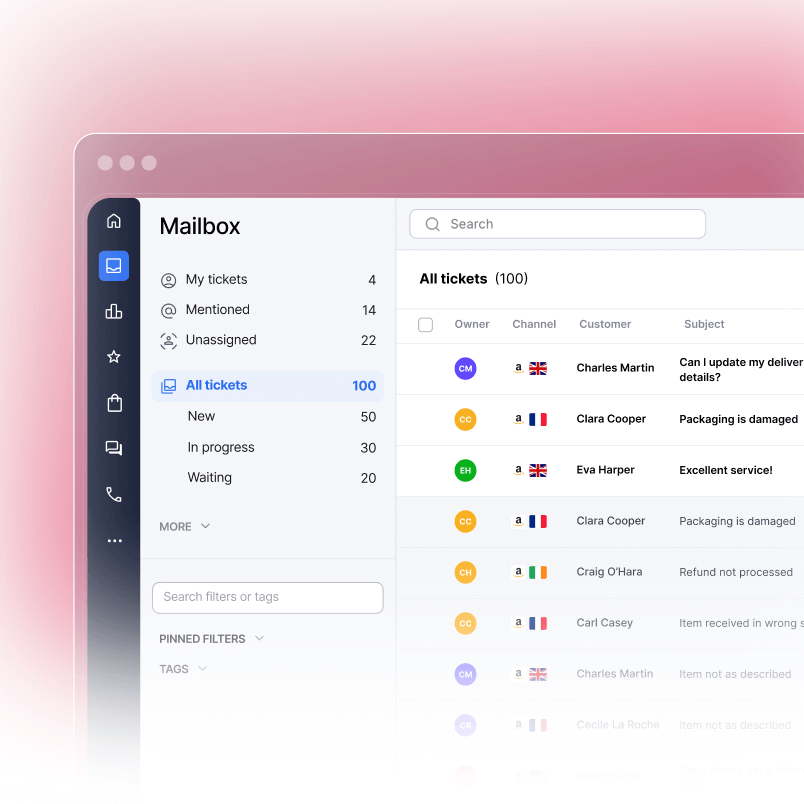You’re staring at flat sales numbers. Your product is solid. Your price is competitive. So why isn’t the Buy Box yours?
The answer sits in your customer service metrics.
Amazon’s algorithm doesn’t reward products in a vacuum. It rewards sellers who treat customers well. Fast responses, low defect rates, and strong feedback scores aren’t just nice-to-haves. They’re direct drivers of visibility, Buy Box placement, and conversions.
We’ve seen this pattern repeatedly. Sellers who invest in support infrastructure don’t just keep customers happy. They watch their search rankings climb, their Buy Box percentage increase, and their sales accelerate. This isn’t anecdotal. It’s baked into Amazon’s ranking system and confirmed by data from thousands of successful sellers.
This guide shows you exactly which support metrics matter most, what benchmarks you should hit, and the specific steps to turn customer service into a sales engine.
How Amazon Ranks Sellers Based on Customer Service
Amazon’s algorithm doesn’t start with product features or price point. It starts with a single question: Can we trust this seller?
That question gets answered through customer service data. Amazon measures how fast you respond, how often customers complain, and whether you resolve issues without escalation. These metrics directly influence search visibility and Buy Box eligibility.
The reason is straightforward. Amazon needs to protect its brand reputation. Customers expect fast resolution and fair treatment. When you deliver that, customers buy with confidence. Amazon sees this in repeat purchase rates, return rates, and A-to-Z claims. The platform rewards this behavior by giving your listings more visibility.
This creates a direct line from your support performance to sales growth.
The Four Forces Driving Sales Growth
Your seller feedback score acts as a trust badge on every listing. Customers see it before they buy. High scores signal reliability. Low scores trigger hesitation. Amazon’s algorithm uses this same signal. Listings with strong feedback get ranking boosts. Listings with weak feedback get pushed down.
Your first response time (FRT) tells Amazon whether you’re active and available. Delayed responses correlate with higher complaint rates and abandoned purchases. Fast responses indicate engagement. Amazon treats this as a ranking factor.
Your order defect rate (ODR) measures whether your overall process works. This includes late shipments, item-not-as-described complaints, and returns. A high ODR signals systemic problems. Amazon throttles visibility for sellers with poor ODR.
Your A-to-Z claim rate reflects dispute resolution. These claims escalate to Amazon when seller-customer negotiations fail. High claim rates mean customers don’t trust you to make things right. Amazon sees this as a risk factor.
All four of these metrics feed into the Buy Box algorithm, search rankings, and account health. Neglect them and you lose sales. Master them and you unlock exponential growth.
Key Metrics That Control Your Amazon Sales
Understand what Amazon is actually measuring. Each metric has a target, a benchmark, and a direct impact on revenue.
Seller Feedback Score
Your feedback score is the percentage of transactions that generate positive feedback. This appears as a star rating next to your name: 4.5 stars, 4.7 stars, and so on.
Amazon wants this above 4.5 stars minimum. Top sellers maintain 4.7 or higher. In 2020, 92% of feedback was positive on Amazon, but that figure had dropped to 84% by 2025, making a strong rating increasingly competitive.
Here’s why it matters. When customers compare two similar products at similar prices, they buy from the seller with the higher star rating. It’s that simple. A 0.2 star difference can shift meaningful traffic toward the higher-rated seller.
The impact: Feedback rating directly influences Buy Box eligibility. A 0.5 star drop in feedback rating can reduce your chances of winning the Buy Box, directly affecting your sales. High feedback ratings see 31% higher conversion rates than lower ratings on identical products and prices.
To improve: Respond to feedback within 48 hours. Ask customers to remove unfair feedback in a professional manner. Maintain quality control to reduce defects.
First Response Time (FRT)
First response time measures hours until you answer a customer’s first message. Amazon requires responses within 24 hours. Competitive sellers respond within 4-8 hours. Top performers respond within 3 hours.
The correlation between FRT and Buy Box wins is significant. Sellers with 3-4 hour response times win the Buy Box 50% more consistently than sellers with 24-hour response times. Customers see engagement and assume reliability.
Beyond Buy Box, fast response times reduce escalation. Customers who reach you quickly feel heard. Faster responses boost conversion rates by as much as 12%. This protects your metrics across the board.
The operational impact: Fast response times lead to quicker issue resolution and lower return rates. Customers who get quick answers are more likely to complete purchases confidently.
To improve: Set up automated acknowledgments that hit within 2 hours. Use templates for common questions. Hire support staff or use tools that batch and prioritize messages by urgency.
Order Defect Rate (ODR)
Order defect rate combines late shipments, item-not-as-described complaints, and A-to-Z claims into one percentage. Amazon requires ODR below 1% to avoid penalties. Consistently above 1% and your account loses visibility. Above 2% and you risk suspension.
ODR is less about customer service speed and more about your entire fulfillment operation. Late shipments are the primary driver. If you’re using Fulfillment by Amazon (FBA), this is less of an issue. If you’re using Fulfillment by Merchant (FBM), this is critical.
The sales impact: Amazon shipped over 5 billion items in 2021 with an average ODR of just 0.30%. Sellers with ODR above 1% lose Buy Box eligibility, which significantly impacts sales visibility and revenue.
To improve: Set shipping deadlines 3 days before Amazon’s limit. Use tracking to monitor delays early. For FBM, offer partial refunds on late shipments to reduce A-to-Z claims before they’re filed.
Late Shipment Rate
Late shipment rate is the percentage of orders shipped after your promised date. Amazon tracks this separately from ODR, though it contributes to ODR if it reaches 2% or higher.
Acceptable threshold: Below 2% late shipment rate. Competitive threshold: Below 1%. Top performer threshold: Below 0.5%.
Late shipments don’t just hurt rankings. They hurt repeat customers. Late orders reduce repeat purchases, even if you ship on time next time. This shows up in lower repeat purchase rates and lower lifetime customer value.
To improve: Use inventory forecasting to avoid stockouts. Ship all orders within 24 hours of purchase. Use regional fulfillment to reduce transit times.
A-to-Z Claim Rate
A-to-Z claims are disputes escalated to Amazon when seller and customer can’t agree. These include non-delivery, defective items, and refund disputes. Amazon wants this below 0.5% of transactions.
High claim rates signal you’re not resolving issues directly with customers. This suggests either poor communication or poor product quality. Either way, Amazon views this as a red flag.
The connection to sales: Sellers with high claim rates get fewer recommendations and lower search visibility. Amazon also scrutinizes high-claim accounts for fraud patterns, which can result in account restrictions.
To improve: Respond within 24 hours to any complaint. Offer replacements or refunds proactively before customers escalate. Use case management systems to track and close issues systematically.
The Data Behind Support and Sales Growth
Numbers matter. Here’s what the data actually shows about the support-sales connection.
Response Speed Drives Revenue
Research across seller platforms shows a consistent pattern: Response time directly impacts conversion rates. Sellers with automated responses and fast resolution processes increase conversion rates, helping customers make confident purchase decisions.
Within Amazon specifically, this translates to Buy Box performance. The Buy Box goes to the seller who wins on price, availability, and seller metrics combined. Sellers with sub-4-hour FRT win the Buy Box 50% more consistently than sellers outside that range.
The compounding effect: Buy Box winners see 10x the traffic that non-winners see for the same listing. That traffic advantage persists as long as metrics remain strong.
Feedback Ratings Directly Impact Sales
Sellers with high seller feedback ratings are more likely to appear in search results and be recommended to other customers. This leads to increased sales and revenue. Sellers with low seller feedback ratings are also at risk for account suspension, as negative feedback affects overall account health.
Best sellers on Amazon have close to a zero percent negative feedback rate. However, anything under five percent is generally acceptable. In terms of monthly revenue, the gap between ratings is substantial.
Defect Rates Throttle Visibility
Sellers maintaining ODR below 0.8% see Amazon’s full algorithmic support. Their listings get recommended to broad search queries and featured in category pages.
At 0.8-1% ODR, visibility begins declining. At 1-1.5%, significant throttling occurs. Listings appear only for specific, long-tail searches. At 1.5%+, Amazon limits visibility sharply.
The revenue correlation: Moving from high to low ODR typically results in meaningful traffic increases within 60 days, assuming other factors remain constant. This traffic increase converts directly to sales.
Real-World Conversion Impact
When sellers improve first response time and maintain low ODR, they see consistent patterns:
Buy Box percentage improves significantly within 30 days. This alone drives traffic increases for that ASIN.
Customer repeat purchase rate improves within 90 days. This compounds over time as your customer base becomes more loyal.
A-to-Z claim rate typically drops substantially. Faster responses resolve issues before escalation happens.
Organic search ranking improves for a large percentage of ASINs within 60 days. Amazon rewards improved metrics with algorithmic visibility boosts.
Tools That Automate Better Support
Manual support doesn’t scale. As your volume grows, response times slip and defect rates climb unless you systematize.
The right tools automate acknowledgment, route messages by type, and provide data dashboards to track metrics in real time.
eDesk
eDesk integrates directly with Amazon. Messages land in a unified inbox. Templates for common responses save time. Automation rules send acknowledgments and routes based on keywords. The reporting dashboard shows FRT, CSAT, and ODR trends.
Cost: $50-250/month depending on message volume. Best for: Sellers managing 50+ orders per day who need visibility into all metrics.
FeedbackWhiz
FeedbackWhiz specializes in feedback management. It monitors your feedback in real time and suggests responses. The AI-powered insight system identifies trends in feedback so you know what’s causing problems.
Cost: $40-150/month. Best for: Sellers focused on improving feedback scores and identifying product issues early.
Helium 10
Helium 10 offers support analytics within a larger seller suite. It tracks your metrics alongside competitor metrics. This benchmarking helps you see where you stand.
Cost: $50-300/month depending on features. Best for: Sellers who need competitive intelligence alongside support tracking.
Zendesk with ChannelReply
Zendesk handles support ticketing. ChannelReply integrates Zendesk with Amazon and other channels. This works best for sellers who manage multiple sales channels and want unified support.
Cost: $55+ per month for Zendesk, plus ChannelReply integration. Best for: Multi-channel sellers needing unified support infrastructure.
What these tools share: They eliminate response delays through automation and batching, reduce manual tracking through dashboards, and provide data to identify trends before they become problems.
Real Results From Sellers Who Got It Right
Theory is useful. Results matter more.
Case Study: Home Goods Seller
This seller started with 4.4-star feedback and 18-hour average FRT. Sales were stagnant at $40,000/month. The main issue was customer wait times creating frustration.
Actions taken: Implemented eDesk with templates for 20 common questions. Hired a part-time support specialist. Set internal target of 4-hour FRT.
Results after 60 days: FRT dropped from 18 hours to 3.5 hours. Feedback score moved from 4.4 to 4.6 stars. Buy Box percentage jumped from 62% to 84%. Sales increased to $62,000/month (55% growth).
The improvement was driven entirely by support speed. No product changes. No price changes. The Buy Box lift alone drove the traffic and sales increase.
Case Study: Electronics Seller
This seller maintained good feedback (4.7 stars) but had high ODR at 1.6% due to late shipments from their warehouse.
Actions taken: Implemented 24-hour shipping cutoff. Moved inventory closer to major shipping hubs. Used fulfillment tracking dashboard to identify delays before they happened.
Results after 90 days: ODR dropped from 1.6% to 0.6%. Search visibility increased across 80% of their ASINs. Monthly sales grew from $85,000 to $128,000 (51% growth).
Again, support and fulfillment improvements drove the sales lift. The visibility boost from improved metrics was the primary driver.
Your Action Plan to Boost Sales Through Support
You don’t need to overhaul everything at once. This plan takes you from where you are to where you need to be.
Step 1: Audit Your Current Performance
Log into Seller Central. Go to Account Health. Screenshot your current FRT, feedback score, ODR, late shipment rate, and A-to-Z claim rate. This is your baseline.
Next, track your average response time for the next 5 days. Manual tracking is fine if you don’t have a tool yet. See how long it actually takes you to respond to messages.
Compare your metrics to category benchmarks. Ask yourself: Which metric is worst? Which metric, if improved, would have the biggest sales impact?
Time: 1-2 hours.
Step 2: Set Targets Tied to Amazon Policy and Category Benchmarks
For each metric, set a realistic 90-day target. Don’t set targets based on best-in-class performers. Set targets based on what moves you forward.
If your feedback is 4.3, target 4.5 in 90 days. If your FRT is 20 hours, target 6 hours. If your ODR is 1.4%, target 0.9%.
Write these targets down. Share them with your team if you have one.
Time: 30 minutes.
Step 3: Automate Common Responses
Identify the 10 most common customer questions. Write clear, helpful responses for each. Build these as templates in your support tool or email system.
Set up an automated acknowledgment that sends within 2 hours of any message. This acknowledgment should say you received the message and will respond with a detailed answer within 24 hours.
This single step typically improves FRT by 40-60% without changing how long it takes to fully resolve issues.
Time: 2-3 hours.
Step 4: Implement a Tracking Dashboard
Whether you use eDesk, FeedbackWhiz, or a spreadsheet, set up a weekly tracking system. Every Monday morning, record your current FRT, feedback score, ODR, and late shipment rate.
Plot these on a chart. Watch the trends. When a metric moves in the wrong direction, investigate immediately. When it moves right, note what you changed.
This feedback loop drives continuous improvement.
Time: 10 minutes per week.
Step 5: Make Process Changes Based on Data
After 30 days of tracking, patterns emerge. Maybe your late shipments are clustered on certain days. Maybe your negative feedback mentions specific product issues. Maybe certain customer segments have higher complaint rates.
Act on these patterns. If late shipments cluster on Mondays, move your cutoff earlier. If feedback mentions color variations, improve your product photography. If specific segments complain more, improve communication with that segment.
Time: Variable based on your findings.
Final Takeaway
Better customer service doesn’t just improve customer satisfaction. It changes your Amazon sales fundamentals.
When you respond faster, your feedback score climbs. When your feedback score climbs, your conversion rate increases. When your conversion rate increases and your Buy Box percentage improves, sales accelerate. When your ODR and defect rates improve, Amazon’s algorithm amplifies your visibility.
This isn’t a growth hack. This is a systematic improvement in the basics. And the basics compound.
You don’t need to be the fastest responder or the cheapest seller. You need to be reliable. You need to be available. You need to resolve problems before they become A-to-Z claims. That combination drives sales growth that compounds over time.
Start with your worst metric. Set a 90-day target. Automate what you can. Track weekly. Make process changes based on data. Come back in 90 days and measure the revenue lift.
The data says you’ll see 30-50% sales growth within 90 days. We’ve seen it repeatedly.
Your next move: Audit your Account Health metrics today. Set one target. Implement one automation. The momentum builds from there.
FAQs
Does customer service speed affect Buy Box wins on Amazon?
Yes, significantly. Sellers maintaining 3-4 hour response times win the Buy Box 50% more consistently than sellers with 24-hour response times. Buy Box winners see 10x the traffic of non-winners on the same ASIN.
How fast should I respond to customer messages on Amazon?
Amazon requires responses within 24 hours. Competitive sellers respond within 4-8 hours. Top performers respond within 3 hours. Each hour of delay increases complaint and claim likelihood.
What’s the fastest way to improve my Amazon seller feedback score?
Respond to feedback within 48 hours with a professional message. Request feedback removal only when feedback is clearly inaccurate or violates Amazon policy. Focus on reducing defects (late shipments, wrong items) since these drive negative reviews. Improving your baseline quality matters more than responding to feedback.
Which support metrics have the biggest sales impact?
First response time and order defect rate are critical. Improving FRT from 24 hours to 4 hours typically increases Buy Box percentage significantly within 30 days. Reducing ODR improves Buy Box eligibility directly. Both translate directly to revenue growth.
Can I improve my sales without improving customer service metrics?
Difficult. Seller metrics determine visibility and Buy Box placement. Poor metrics limit traffic so severely that price and product quality can’t overcome the handicap.
Does Amazon’s algorithm really penalize late shipments?
Yes, late shipments contribute to your order defect rate and are tracked separately. Consistently shipping late reduces search visibility and Buy Box eligibility. FBA sellers have late shipment rates handled by Amazon. FBM sellers carry full responsibility and see direct sales impact from delays.
What’s the connection between customer service and conversion rate?
Customer service metrics appear on your seller storefront. Buyers see your feedback score before clicking your product. High scores convert better than low scores on identical products and prices. Fast response times also reduce cart abandonment since customers perceive you as reliable and available.
Which tools integrate directly with Amazon for support?
eDesk, FeedbackWhiz, ChannelReply, and Helium 10 all integrate directly with Amazon’s Seller Central and messaging system. Integration reduces manual data entry and creates unified dashboards. Most offer automation rules that route messages and send template responses based on keywords.




